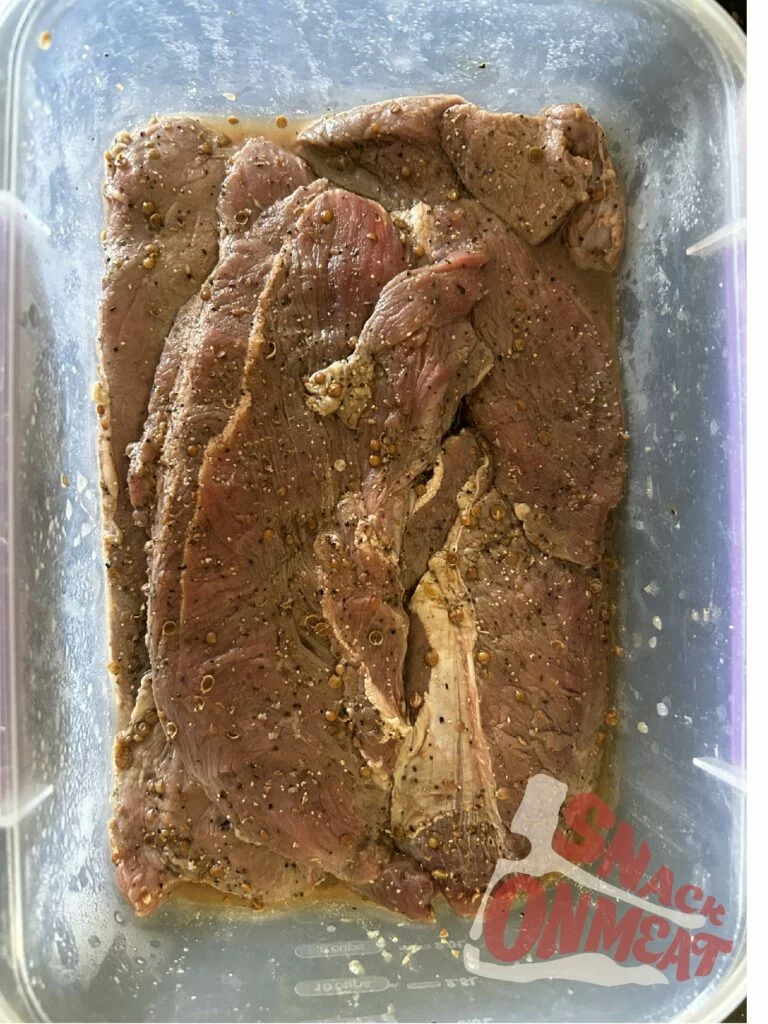If you’re a novice in the realm of crafting your own biltong, fear not – we’re here to guide you through an easy, step-by-step process to create authentic biltong right in your kitchen.
In this blog post, we’ll take you on an exploration of biltong making, providing you with a step-by-step biltong recipe for beginners. And while the recipe is simple (biltong is meant to be simple), it also promises not to compromise on authenticity.
By selecting the right meat, choosing authentic spices and slowly drying your biltong, you will have the most authentic and delicious outcome.
This step-by-step guide will walk you through the process, where authenticity meets simplicity in crafting the perfect biltong for beginners.
How to Make Biltong for Beginners: The Basics
1. What is Biltong? Biltong is a South African dried meat snack that traces its roots back to the early Dutch settlers. Biltong was created out of necessity as there was no refrigeration and it needed to be kept for long periods. By curing with salt and vinegar, the meat was able to be slowly air-dried and kept for months on end. Typically biltong is made from beef, game meats, or ostrich, but in modern times it is made with nearly any meat available.
2. What Makes Biltong Special? Unlike jerky, which is often smoked and dehydrated quickly, biltong is slowly air-dried, resulting in a more tender and succulent texture. The process also involves marinating the meat in a blend of spices & vinegar, which gives biltong its distinctive taste (much different to jerky). Biltong typically is salty and savoury with the distinct flavour of coriander seeds and pepper.

Ingredients For Biltong: The Essentials
Before you dive into biltong making, make sure you have the following ingredients:
- 1 kilogram of beef (Topside or Silverside works best)
- 1 cup of brown vinegar
- 2 tablespoons of coarse salt
- 2 tablespoons of crushed coriander seeds (toasted)
- 1 tablespoon of ground black pepper
- Optional: 1 teaspoon of brown sugar (this can help to soften the biltong & prevent case hardening)
- Optional: crushed chilli flakes for a spicy kick
Equipment Checklist For Making Biltong
Prepare your workspace with the necessary tools:
- A sharp knife for cutting the meat (A chef’s meat knife is ideal, but any very sharp knife will do)
- A non-metallic container for marinating (glass or ceramic is best, also having a seal-able lid will help prevent contamination and spills)
- A biltong box or a well-ventilated area for drying
- Butcher’s hooks or paper clips bent into S hooks for hanging the meat (Finding the paper clips coated in plastic is a good option)
- Additional Options: Paper towel or Aluminium foil for the bottom of your biltong box
Step-by-Step Guide to Making Biltong
Step 1: Choose a high-quality cut of beef, preferably Topside or Silverside, and ensure it’s free of excess fat. Trim any visible fat as it can affect the drying process. (Some people like to keep some fat on but as a beginner keep it lean).
Step 2: With a sharp knife, slice the meat into strips between 1-3cm (the width of your thumb). For a tender result, Remember to always slice with the grain (this is not jerky).

Step 3: Take your sliced meat and sprinkle both sides with your mixture of salt, pepper and crushed coriander seeds (toasting the coriander seeds first brings more flavour).

Step 4: In a non-metallic dish, sprinkle some brown vinegar on the base (you can use a spray bottle also), lay your pieces of spiced meat to create one layer, then sprinkle more vinegar on top. Repeat this layer by layer, until all your meat is layered in the dish.

Step 5: Cover the dish and refrigerate for at least 4 hours (up to 24 hours depending on how intense you want the flavour), this allows time for the flavours to infuse and moisture to draw out from the meat.
Step 6: Remove the meat from the marinade and pat it dry with paper towels. You can also rinse off the marinade in a mixture of 1 part water to 1 part vinegar, then pat dry. (Some people believe this step is unnecessary, although it will guarantee your biltong won’t be overly salty).
Step 7: Thread the meat strips onto butcher’s hooks or S paper clips. Placing the hook at the top, in the thickest part of the meat.

Step 8: Drying the Biltong Hang the meat in a well-ventilated area or a Biltong box with good air circulation. Allow it to air-dry for 3-5 days, depending on your desired level of dryness. Begin to check your biltong after 3 days and leave it no more than 7.

Step 9: After the drying period, check the biltong for the desired dryness. It should be firm to the touch but still slightly pliable. (Slice into the end of one of your pieces and taste it to see if it’s done enough for you). If needed, extend the drying time for a more dry texture.

Step 8: Once ready, slice the biltong into thin strips against the grain. It’s now ready to be enjoyed as a flavourful, protein-packed snack.

FAQs for Biltong Beginners
Q1: Can I use other types of meat besides beef?
Yes. While beef is the traditional choice, biltong can be made with game meats, ostrich, lamb and even bacon. Experiment with different meats to discover your favourite flavours. This article talks about all the possible meat choices for making biltong.
Q2: What if I don’t have a biltong box?
If a biltong box isn’t available, you can hang the meat in a well-ventilated area. Ensure good air circulation to facilitate the drying process. This can be done by adding a fan to the area to circulate air around the meat (do not face the meat directly). This post will tell you all the best ways to dry biltong, including how to make your own biltong box!)
Q3: How can I adjust the spice level?
Feel free to customize the spice level to your preference. Add more chilli flakes or adjust the pepper content in the marinade for a spicier or milder biltong. It’s important to keep a certain amount of salt and vinegar as this is crucial for curing the meat and removing harmful bacteria. This article has a helpful salt calculator to ensure you always have the perfect amount.
Q4: Can I store biltong for an extended period?
Biltong has a long shelf life, especially when stored in a cool, dry place. It can last for several weeks to months if properly vacuum sealed and stored in the fridge. This blog post about the best way to store biltong will help keep biltong for the longest time possible.
Q5: Can I use a dehydrator instead of air-drying?
While traditional biltong is air-dried, a dehydrator can be used as an alternative. Follow the method in this blog post for the best way to make biltong in a dehydrator.
Q6: Can I use any type of vinegar for the marinade, or is there a specific one recommended?
While brown vinegar is the traditional choice for biltong, you can experiment with different types. Apple cider vinegar adds a unique tanginess and red wine vinegar can impart a deeper flavour. This article provides a rundown of all the vinegar options.
Q7: Is it essential to hang the biltong in a well-ventilated area, or can I use a dehydrator with similar results?
While the traditional method involves air-drying in a well-ventilated space, using a dehydrator is a convenient alternative. Set the dehydrator to a low temperature and follow its guidelines for drying meat. Both methods can yield delicious results.
Q8: Can I add additional herbs or spices to the marinade for extra flavour?
Absolutely! Biltong is incredibly versatile, and you can enhance the marinade with additional herbs or spices. Paprika, garlic powder, or even a touch of cayenne pepper can add depth to the flavour profile. Feel free to get creative and tailor the recipe to your taste buds. This post shares the best spices to use for biltong, including experimental choices.
Q9: Can I make biltong without using sugar in the marinade?
Yes, you can omit the sugar from the marinade if you prefer a biltong with a less sweet profile. The sugar helps balance the flavours, but its absence won’t compromise the overall success of your biltong. Adjusting the spice levels or experimenting with alternative sweeteners is another option for customization.
Recent Posts:
- The Truth About Beef Jerky And Your Health
 A favourite among outdoor enthusiasts for its transportability, for fitness enthusiasts …
A favourite among outdoor enthusiasts for its transportability, for fitness enthusiasts … - Kangaroo Biltong: How To Make It
 We all know beef, game, and ostrich are the most traditional …
We all know beef, game, and ostrich are the most traditional … - What Is Biltong? Everything You Need To Know
 In the world of savoury snacks, one delicacy stands out for …
In the world of savoury snacks, one delicacy stands out for …





